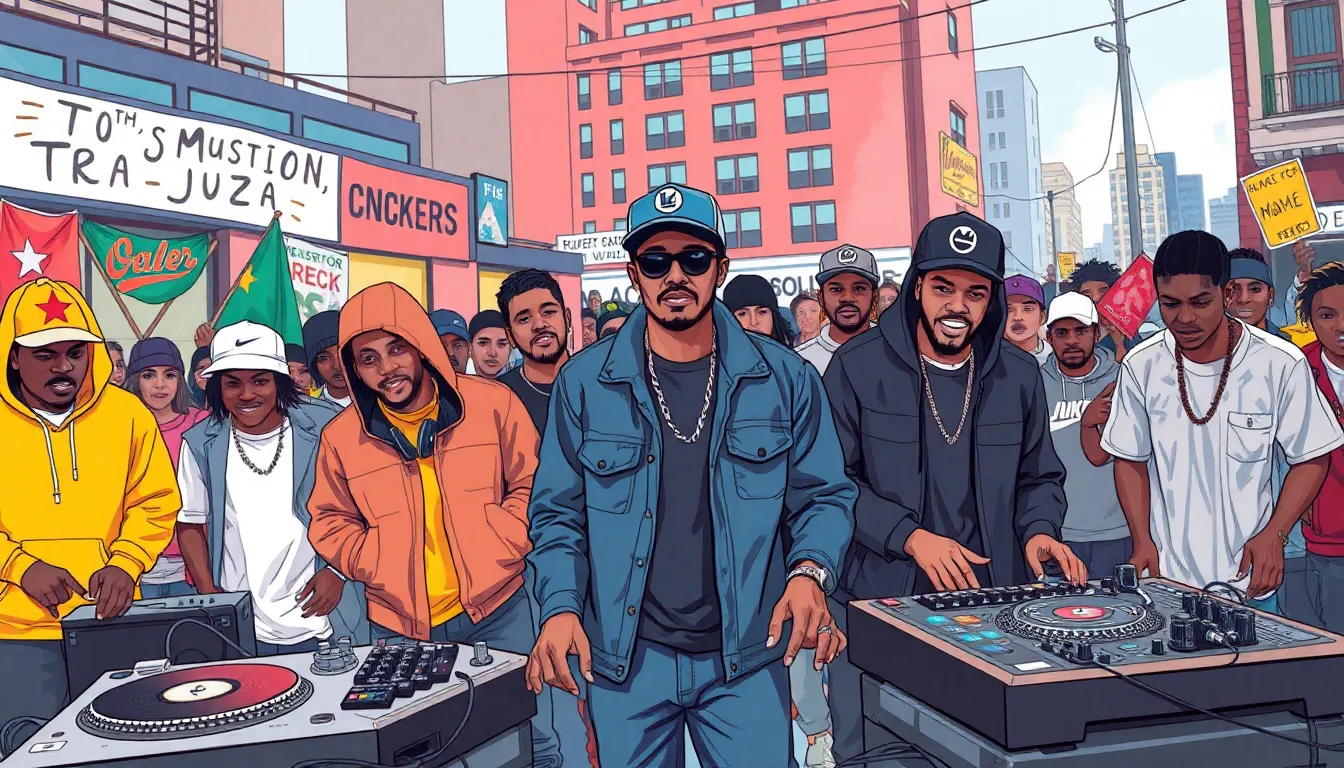Hip-hop samples are like the secret sauce of the genre, blending the old with the new in a deliciously creative way. They take listeners on a nostalgic journey while keeping the beats fresh and exciting. Ever wondered how a classic soul tune can morph into a banger that gets everyone on the dance floor? That’s the magic of sampling!
From the funky grooves of the ’70s to the catchy hooks of the ’90s, hip-hop artists have mastered the art of reimagining sound. It’s not just about recycling; it’s about reinventing. In a world where originality is king, sampling proves that sometimes, the best ideas come from the past. So buckle up as we dive into the fascinating world of hip-hop samples, where every beat tells a story and every loop has a legacy.
Table of Contents
ToggleOverview Of Hip-Hop Samples
Sampling plays a crucial role in hip-hop music, serving as a bridge between different eras and styles. Artists utilize samples to create unique beats, breathing new life into classic tracks from various genres. This practice allows musicians to draw inspiration from jazz, soul, funk, and rock, integrating those sounds into modern compositions.
Creativity defines hip-hop sampling, with producers dissecting snippets of songs to craft something entirely new. Numerous techniques are employed, including looping, chopping, and pitch shifting, which transform original music into fresh material. Each sample carries its own story and emotion, reflecting the heritage and heritage of the sampled track.
The legal aspects of sampling also warrant attention. Clearances often require permission from original artists or rights holders, which can be a complex process. Sometimes, artists choose to create unauthorized samples, risking potential legal ramifications. Understanding these elements plays a vital role in the sampling process.
Sampling not only influences the sound of hip-hop but also shapes its culture. Many hip-hop songs pay homage to the artists who came before, fostering a sense of community and respect within the genre. This practice connects generations of music lovers, promoting a continuous dialogue between past and present sounds.
Throughout hip-hop’s evolution, sampling remains a foundational element. Producers and artists innovate constantly, pushing boundaries and expanding the genre’s possibilities. Analysis of hip-hop samples reveals a rich tapestry of musical influence and artistic expression, captivating audiences worldwide.
The History Of Sampling In Hip-Hop

Sampling in hip-hop traces back to the genre’s beginnings, showcasing a rich tapestry of sound and innovation. Artists have drawn from diverse musical landscapes to create unique compositions.
Early Influences
New York City’s block parties in the 1970s marked sampling’s initial emergence. DJs like Kool Herc pioneered techniques by combining beats from funk and soul tracks. The use of breakbeats gained popularity, allowing hip-hop to thrive in urban spaces. Influential tracks, like “Rapper’s Delight” by The Sugarhill Gang, showcased how sampling could redefine music. Notably, tracks from artists like James Brown and George Clinton provided essential elements that defined the genre. These early influences laid the groundwork for sampling’s significance throughout hip-hop.
Key Innovations
Technology played a crucial role in sampling advancements. In the 1980s, the introduction of the Akai MPC revolutionized how artists manipulated sounds. The MPC enabled producers to sample, loop, and layer beats seamlessly. This accessibility fostered a creative boom in the late 1980s and 1990s, with artists like Public Enemy and A Tribe Called Quest pushing boundaries. Their innovative use of samples showcased complex arrangements and genre-blending styles. As digital technology evolved, sampling became more sophisticated, providing endless possibilities for producers. This innovation propelled hip-hop into new realms while solidifying its impact on music culture.
Iconic Hip-Hop Samples
Hip-hop samples serve as a cornerstone, connecting past music to contemporary sounds. Notable examples illustrate this rich history and its impact on modern tracks.
Classic Tracks
“Think (About It)” by Lynn Collins stands out as a pivotal sample in hip-hop. The iconic “Apache” breakbeat captured listeners’ attention, appearing in countless tracks. “Funky Drummer” by Clyde Stubblefield provides another essential element, laying the foundation for memorable beats in songs like “Fight the Power” by Public Enemy. “Amen Brother” by The Winstons also deserves recognition, with its drum break influencing multiple genres. These classic samples inspired creativity across hip-hop’s evolution and emphasized the genre’s ability to reinvent itself.
Notable Artists
J Dilla remains a revered figure in the sampling scene. His innovative approach pushed boundaries, creating intricate soundscapes. DJ Premier also deserves mention, known for crafting hard-hitting samples in tracks like “Mass Appeal” by Gang Starr. Kanye West’s sampling techniques revolutionized the genre, blending different sounds in groundbreaking ways. These artists showcase how sampling allows hip-hop creators to honor the past while paving the way for the future. Their contributions highlight the ongoing evolution and significance of iconic samples within the genre.
The Art Of Sampling
Sampling embodies creativity in hip-hop, blending sounds from past eras into modern beats.
Techniques And Methods
Producers utilize various techniques to manipulate samples. Looping allows them to repeat a segment of audio, creating a rhythmic foundation. Pitch shifting alters the sample’s tone, providing unique soundscapes. Layering involves stacking multiple samples, adding depth and complexity to a track. Filtering removes certain frequencies from a sample, allowing for more clarity in mixes. Artists often incorporate effects like reverb or delay, enhancing the overall texture. Through these methods, hip-hop producers craft innovative compositions that resonate with listeners, transforming original works into something fresh.
Legal Considerations
Navigating legal aspects of sampling is crucial for hip-hop artists. Clearances often require permission from original copyright holders, which can be complex and time-consuming. Unauthorized sampling poses risks, leading to potential lawsuits and financial losses. Music publishers and labels frequently own rights to recordings, making negotiations essential. Fair use may apply in certain situations, but this rarely covers commercial releases. Understanding these legal frameworks helps artists protect their work while paying homage to the originals. Many producers seek legal guidance to manage sample rights effectively, ensuring their music remains a tribute rather than a liability.
Future Of Hip-Hop Samples
Technological advancements continue to influence hip-hop sampling. Innovations in software and hardware provide producers with new tools for creativity. Artificial intelligence has begun to play a prominent role, offering features that can analyze songs and suggest potential samples. These tools streamline the sampling process, enabling artists to experiment with sounds quickly.
Increasingly, collaboration among artists across genres is becoming common. This trend allows creators to fuse diverse influences, leading to fresh sounds. Collaborations also lead to broader access to unique samples, enhancing the genre’s overall richness. New platforms for sharing and distributing music further democratize the sampling process. Artists now easily share their works, potentially reaching larger audiences.
Legal frameworks regarding sampling continue to evolve. More artists are pursuing proper clearances to lessen the risk of litigation. Emerging licensing models explore alternative methods for securing rights to samples, including revenue sharing arrangements. With these changes, artists navigate the complexities of sampling with greater confidence.
Emerging artists increasingly adopt sampling as a way to showcase their influences. Familiar sounds resonate with listeners, fostering connections between generations. This connection strengthens hip-hop’s foundational elements while encouraging experimentation. Sampling also cultivates respect for musical history, bridging the gap between past and present.
Sampling will likely adapt continuously as hip-hop evolves. The genre thrives on innovation, and artists remain driven to explore uncharted territory. As hip-hop embraces new technologies and ideas, sampling remains a vital force in shaping its future. New sounds and methodologies will expand hip-hop’s creative landscape.
Sampling is a vital force in hip-hop that bridges the past and present. It allows artists to pay homage to their influences while creating something entirely new. As technology continues to evolve, the possibilities for innovative sampling techniques expand, encouraging fresh sounds and collaborations.
Navigating the legal landscape remains essential for artists, ensuring they honor original creators while safeguarding their work. With emerging artists embracing sampling, the genre’s rich history and future potential intertwine seamlessly. Hip-hop sampling not only shapes the music but also fosters a deeper connection among generations of listeners.



